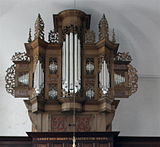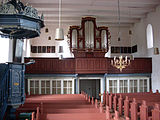Valentin Ulrich Grotian
Valentin Ulrich Grotian (born August 24, 1663 in Goslar ; † May 19, 1741 in Aurich ) was an organ builder who worked in East Frisia from 1688 to 1707 at the latest . Seven new organs come from him, of which only the organ in Pilsum (1694) is almost completely preserved.
Life
Grotian was born in Goslar in 1663. Nothing is known about his apprenticeship years in the Harz foreland . His work in the organ landscape of East Friesland is documented from 1688 when he carried out an organ repair in the Lambertikirche Aurich . In 1694 he married Anna Margarethe Bungarts in Petkum . He was a contemporary of Arp Schnitger , who did not tolerate any competition in the north-west German coastal area. Only in East Frisia and Jeverland were Grotian and Joachim Kayser able to distinguish themselves for a certain period of time through independent works alongside Schnitger. When he married Anna Sophia Volgern in 1708, he was referred to as the “Hochfürstlicher Ausmiener” ( auctioneer ). This job title can also be found in his death register. After 1700, Grotian evidently turned to another profession, so that it can be assumed that he was ousted by Schnitger or that he changed his profession for economic reasons.
plant
Between 1691 and 1699 Grotian carried out seven new buildings in East Friesland. The organ in Pilsum (1694) is his only work that has largely been preserved in its original condition. Schnitger's large organ in the Ludgerikirche Norden was built only a few years earlier and allows an interesting comparison. Grotian's organs were more traditionally made, while Schnitger's instruments were considered progressive at the time. Thanks to the restoration by Jürgen Ahrend , the Pilsum organ was made fully functional again in 1991 and the original sound and optical condition was completely restored. Along with the Schnitger organs, the instrument is the most important work in East Frisia around 1700. It has 16 registers on two manuals and an attached pedal , which offers the possibility of expanding an independent pedal unit later. The organ has clearly colored sounds and differs greatly from Schnitger in its sound concept. The pipes, which contain a lot of lead, point back to the time of traditional organ building. The lengths of the flute stops are unusual .
The new buildings by Grotian in Werdum (around 1690) and the Reformed Church in Bunde (1691–1692) had to give way to later organs. Only the brochures of the instruments in Aurich-Oldendorf (1692) and Weene (1698–1699) have survived . The organ in Petkum (1694–1699) has suffered a lot over time; after all, quite a few registers are still old; restoration is still pending here. In Stedesdorf (1696) the reconstruction by Arnold Rohlfs (1847–1849) changed the organ significantly. Only the case of the small organ in Greetsiel (1694–1695) is old. Various repair measures by Grotians, such as a. in the Lambertikirche in Aurich (1688 / ca. 1703), in Rysum (1689–1690 / 1699) and Groothusen (1694).
List of works
The size of the instruments is indicated in the fifth column by the number of manuals and the number of sounding registers in the sixth column. A capital “P” stands for an independent pedal, a lowercase “p” for an attached pedal. Italics indicate that the organ in question is no longer available or that only the prospectus has been preserved.
| year | place | church | image | Manuals | register | Remarks |
|---|---|---|---|---|---|---|
| 1688 / around 1703 | Aurich | Lamberti Church | II | Repair of the organ from the 16th century; not received | ||
| 1688 | Victorbur | St. Victor Church | I. | 8th | Repair of the organ from the 16th century; not received | |
| 1689-90 / 1699 | Rysum | Rysumer Church |

|
I. | 7th | Repair of the → organ from 1457; receive |
| around 1690 | Become | St. Nicolai Church | I / p | 9 | New building; not received | |
| 1691-1692 | Bundles | reformed Church | II / p | 17th | New building; 1791/92 sold and transferred to Aurich-Oldendorf, where the prospectus has been preserved | |
| 1692 | Aurich-Oldendorf | St. Peter's Church | II / p | 17th | Transferred from the Reformed Church to Bunde ; only received prospectus | |
| 1693 | Great Midlum | Great Midlum Church | Repair of the organ from the 16th century; not received | |||
| 1694 | Pilsum | Pilsum Kreuzkirche |

|
II / p | 16 | → Organ of the Pilsum Kreuzkirche , new building, almost completely preserved |
| 1694 | Groothusen | Groothuser Church | Repair of the organ by Master Petrus von Emden (1520); not received | |||
| 1694-1695 | Greetsiel | Greetsieler Church | New building; not received | |||
| 1696 | Stedesdorf | St. Aegidien Church |

|
I / p | 9 | New building; Replaced by Arnold Rohlfs from 1847–1849 with a new building, four retained Grotian registers have been preserved. |
| 1697 | Wittmund | St. Nicolai | II / P | Repair of the organ by Arp Schnitger (1684); not received | ||
| 1694-99 | Peccum | St. Anthony Church |

|
II / p | 14th | New building; received five registers |
| 1698-1699 | Weene | Nikolaikirche |

|
I / p | 11 | New building; only received prospectus |
literature
- Walter Kaufmann : The organs of East Frisia . East Frisian Landscape, Aurich 1968.
- Harald Vogel , Günter Lade, Nicola Borger-Keweloh: Organs in Lower Saxony . Hauschild, Bremen 1997, ISBN 3-931785-50-5 .
- Harald Vogel, Reinhard Ruge, Robert Noah, Martin Stromann: Organ landscape Ostfriesland . 2nd Edition. Soltau-Kurier-Norden, Norden 1997, ISBN 3-928327-19-4 .
See also
| personal data | |
|---|---|
| SURNAME | Grotian, Valentin Ulrich |
| BRIEF DESCRIPTION | German organ builder |
| DATE OF BIRTH | August 24, 1663 |
| PLACE OF BIRTH | Goslar |
| DATE OF DEATH | May 19, 1741 |
| Place of death | Aurich |
